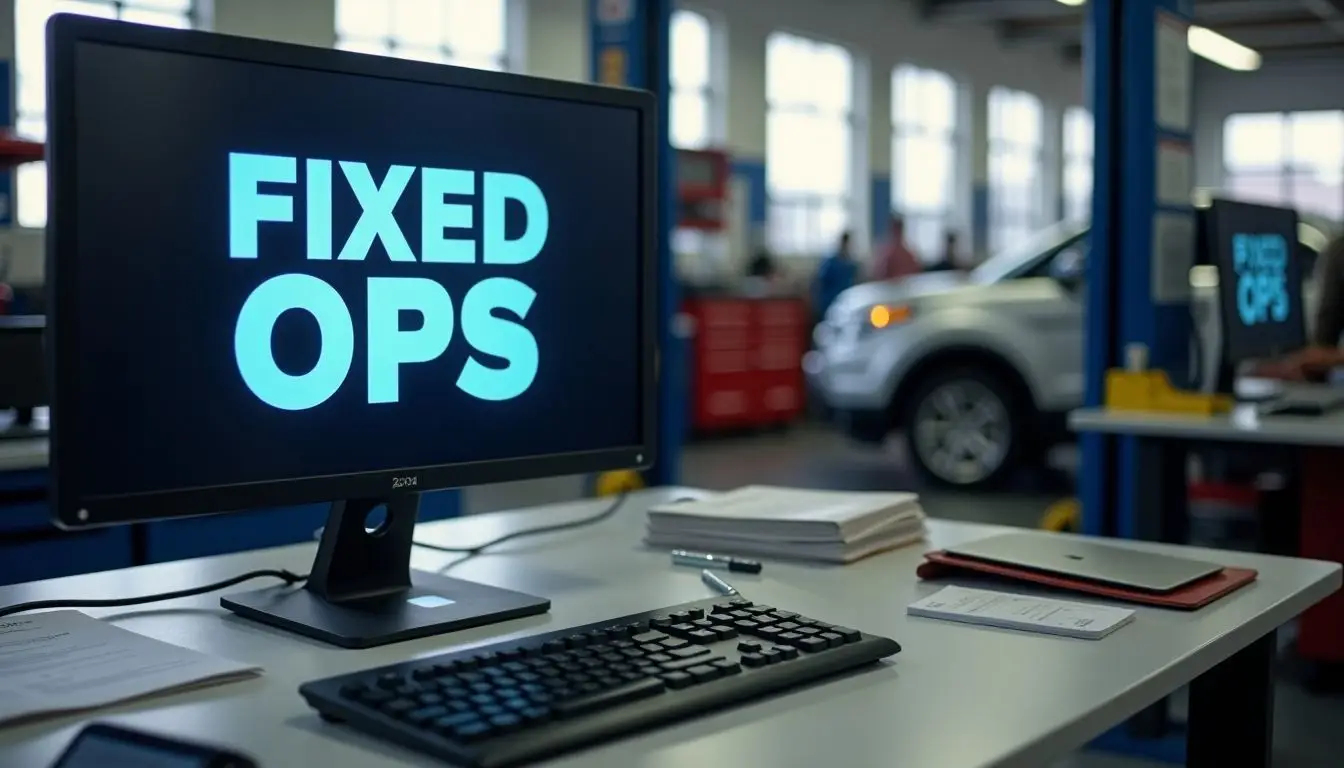In car dealerships, knowing how well service advisors do their job is key. If they do well, the dealership makes more money and customers are happier. A tool called the Digital Fixed Ops Leaderboard helps with this.
It looks at things like how satisfied customers are, how much a repair costs on average, and how quickly technicians work. This blog will show how using Key Performance Indicators (KPIs) can make service advisors and the whole dealership do better.
We’ll talk about why it’s important for service advisors to improve and how technology like digital leaderboards can help. You’ll learn about training that makes advisors even better at their jobs.
Also, we will explore ways to keep customers happy so they come back again. Read on to find out how to reach success in your automotive service department!
Key Takeaways
- Service advisors are important in car dealerships. They help make customers happy and bring in money. A tool called the Digital Fixed Ops Leaderboard checks how well they do this by looking at things like customer happiness, how much repairs cost, and how fast work gets done.
- Key Performance Indicators (KPIs) track service advisor success. Important KPIs include customer satisfaction scores, average repair order value, and technician productivity rates. These numbers show where service advisors do well or need to improve.
- Technology helps keep track of performance. Digital leaderboards rank service advisors by their results. This motivates them to do better by seeing their ranking compared to others.
- Ongoing training makes service advisors better at their jobs. Training covers skills like talking to customers and understanding car repairs more deeply.
- Good relationships with customers are key for business success. Using data from past visits can personalize services, making sure customers keep coming back.
Table of Contents
ToggleImportance of Optimizing Service Advisor Performance

Service advisors play a key role in dealership success. Their performance affects customer satisfaction and revenue generation directly.
Why service advisor performance is crucial

Service advisor performance is crucial for dealership success. Good performance leads to higher customer satisfaction and boosts revenue generated. Service advisors are often measured using a digital leaderboard that tracks their KPIs.
Common KPIs include customer satisfaction scores, average repair order value, and technician productivity rates. High rankings on the leaderboard help motivate service advisors and improve overall dealer performance.
Strong performance in service metrics directly impacts gross profit and customer retention. Effective labor rates and hours sold per repair order are key indicators of efficiency. The Fixed Ops Leaderboard shows how well each advisor is doing, allowing everyone to strive for better results in sales targets and operational excellence.
Common challenges faced by service advisors

Service advisors face many challenges. These can affect their performance and dealership success.
- High customer expectations create pressure. Customers want quick and efficient service while also expecting friendly interaction. Meeting these demands can be tough for advisors.
- Balancing multiple tasks is difficult. Advisors must handle calls, meet customers, and manage work orders all at once. This can lead to mistakes or missed opportunities.
- Low motivation affects performance. If service advisors feel undervalued, their sales performance may drop. Motivation is key to keeping them engaged and productive.
- Lack of training can hinder growth. Ongoing training is crucial for improving skills and knowledge in the automotive field. Without it, advisors may struggle to meet efficiency benchmarks.
- Communication gaps with technicians arise often. Misunderstandings about repair needs can delay service times and reduce customer satisfaction scores (CSI). Clear lines of communication are vital for smooth operations.
- Technology use can be overwhelming at times. Digital fixed ops leaderboards provide insights but may require time to learn effectively. Advisors need support to fully utilize these tools for performance management.
- Repair order complexity leads to confusion sometimes. Advisors must understand various services offered and how they affect invoicing and revenue generated per order. Complicated repairs can make advising customers more challenging.
- Fluctuations in parts inventory impact service delivery as well… Delays in receiving parts can slow down repair times, leading to unhappy customers who expect timely service.
- Competition among dealerships contributes stress too… Advisors know they are being ranked against others based on KPIs like technician productivity rates and average repair order value.
- Lastly, adapting to changing dealership goals is tough for many advisors… As metrics for success evolve, staying aligned with new targets demands flexibility and focus from all team members involved in fixed operations.
Impact on dealership success
Service advisors play a key role in dealership success. Their performance directly affects customer satisfaction and overall revenue. The Fixed Ops Leaderboard tracks important metrics like customer satisfaction scores and average repair order value.
By monitoring these KPIs, dealerships can spot areas for improvement.
High service efficiency boosts profits and keeps customers happy. The leaderboard also ranks dealers based on their service metrics. This helps motivate employees to perform better.
A strong focus on these KPIs leads to growth and long-term success in the automotive industry.
Key Performance Indicators (KPIs) for Service Advisors

Key Performance Indicators (KPIs) help measure how well service advisors do their jobs. These indicators show areas where they excel and where they can improve.
Definition and importance of KPIs
Key Performance Indicators (KPIs) are important tools that help measure how well service advisors perform. They track key metrics like customer satisfaction scores and technician productivity rates.
These indicators show what is working and what needs improvement.
KPIs guide service advisors to reach their goals and improve dealership success. They provide insights into revenue generated, average repair time, and parts inventory. Using these metrics helps create a culture focused on excellence in fixed operations within the dealership environment.
Recommended KPIs for service advisors
Service advisors play a key role in a dealership’s success. Proper performance metrics help track their effectiveness.
- Customer Satisfaction Index (CSI) Scores: These scores show how happy customers are with service. High CSI scores lead to more repeat business and positive reviews.
- Average Repair Order Value: This measures how much money, on average, each customer spends per service visit. A higher average means better revenue for the dealership.
- Technician Productivity Rates: This KPI tracks how efficiently technicians work on repairs. Higher productivity leads to faster service and happier customers.
- Service Efficiency: This metric looks at how quickly services are completed relative to time booked. Efficient service keeps customers satisfied and increases profit margins.
- Effective Labor Rate: This shows the average rate the dealership charges for labor compared to competitors. A favorable rate can improve sales performance and attract more clients.
- Hours Sold Per Repair Order: This indicates the number of hours billed for each repair job. Increasing this number boosts overall earnings for the department.
- Revenue Generated: Tracking total revenue from the service department is critical for assessing financial health. More revenue means greater profitability.
- Average Repair Time: This measures the time taken to complete repairs. Shorter repair times improve customer satisfaction and increase service throughput.
- Parts Inventory Management: Keeping track of parts inventory ensures necessary items are available for repairs quickly, reducing delays for customers.
- Invoicing Accuracy: This KPI checks if billing is done correctly without errors or disputes, enhancing customer trust and leading to higher retention rates.
These KPIs help optimize performance for service advisors within digital fixed operations, driving success in the automotive industry.
Utilizing Technology for Performance Optimization

Technology plays a key role in tracking service advisor performance. Digital fixed ops leaderboards offer clear insights to boost productivity and motivate staff.
Role of technology in tracking and monitoring performance
Technology plays a big role in tracking and monitoring service advisor performance. Digital leaderboards show various KPIs, like customer satisfaction scores and average repair order value.
These tools help dealerships see how well they are doing at a glance. They rank service advisors based on their metrics, which motivates them to improve.
Using these digital systems also helps spot common challenges that service advisors face. Insightful data can lead to better training programs and improved strategies for success. This maximizes service advisor performance and drives excellence in fixed operations across the dealership.
Benefits of digital fixed ops leaderboards
Digital fixed ops leaderboards help service advisors track their performance. These tools boost success in dealerships.
- Clear Performance Metrics: Digital leaderboards show clear numbers for each service advisor. They display KPIs such as customer satisfaction scores and average repair order value. This clarity helps advisors understand where they stand.
- Enhances Motivation: Service advisors gain motivation by seeing their rankings. A visible leaderboard sparks friendly competition among staff. This can lead to better service performance overall.
- Identifies Improvement Areas: Digital leaderboards highlight areas needing improvement. If an advisor has low technician productivity rates, they can target that issue quickly. This focus helps boost overall efficiency.
- Real-Time Feedback: Advisors receive immediate feedback on their work. Tracking metrics like invoicing rates and parts inventory helps them adjust quickly if needed.
- Supports Accountability: With all data displayed, accountability is high among service advisors. Everyone knows what is expected of them as they see their current standings openly.
- Promotes Team Collaboration: Leaderboards encourage teamwork within the service department. Advisors often share tips and strategies to improve each other’s performance on shared KPIs.
- Boosts Revenue Generation: Higher visibility into metrics leads to better decision-making around repairs and sales prices, which can increase revenue generated per job.
- Aids in Retention Strategies: Understanding customer satisfaction index (CSI) scores lets advisors create personalized services for clients, increasing retention rates over time.
- Improves Operational Efficiency: By monitoring average repair time closely, service departments can streamline operations and reduce delays in servicing vehicles.
- Direct Influence on Dealership Success: The insights provided by digital leaderboards are crucial for overall dealership profitability, helping leaders make informed decisions based on clear data trends.
Training and Development for Service Advisors

Ongoing training helps service advisors improve their skills. Simple strategies can boost their performance and confidence in the job.
Importance of ongoing training and development
Training and development help service advisors improve their skills. Ongoing training ensures they stay updated with the latest practices. It boosts customer satisfaction scores, which are vital KPIs for success.
Service advisors who receive effective training perform better in areas like repair order value and technician productivity rates.
Regular learning also builds confidence. Advisors feel more comfortable using tech tools, like digital leaderboards. These tools track sales performance and motivate them to excel.
Constant improvement helps dealerships increase revenue and enhance overall operations in fixed ops. The focus on ongoing growth leads to better results for both advisors and the dealership as a whole.
Effective strategies for improving performance
Service advisors can boost their performance with the right strategies. Implementing these tips can lead to better results on the digital fixed ops leaderboard.
- Set Clear Goals
Define specific Key Performance Indicators (KPIs) for each service advisor. Common KPIs include customer satisfaction scores and average repair order value. These clear goals help advisors know what to aim for.
- Use Digital Tools
Monitor performance through a digital leaderboard. This technology tracks metrics like technician productivity rates and service efficiency. It motivates service advisors by showing real-time results.
- Encourage Team Collaboration
Promote teamwork among service advisors and technicians. Strong communication leads to faster repairs and happier customers, which improves overall dealership success.
- Provide Regular Feedback
Offer continuous feedback based on KPI results. Discuss areas of improvement in regular meetings. Timely feedback helps advisors make quick adjustments to their work practices.
- Invest in Training Programs
Ongoing training is crucial for improving skills and knowledge. Cover topics like customer service and technical skills that affect performance directly. This investment pays off in higher revenue generated per repair order.
- Recognize Top Performers
Reward the best-performing service advisors regularly. Use trophies or bonuses as incentives based on KPIs such as parts inventory management or average repair time. Recognition boosts motivation within the team.
- Analyze Customer Feedback
Review Customer Satisfaction Index (CSI) scores regularly to identify strengths and weaknesses in service delivery. Understanding customer needs can lead to improved relationships and retention rates.
- Adjust Strategies Based on Data
Use data from the digital fixed ops leaderboard to adjust strategies when necessary. Analyze trends in performance over time, such as labor rates or hours sold per repair order, to make informed decisions.
- Foster a Positive Work Environment
Create a work culture that promotes growth and encourages open communication among staff members at all levels of the dealership.
- Focus on Personalization
Leverage customer data for personalized services where possible, leading to better relationships with clients and repeat business due to increased satisfaction levels.
Customer Relationship Management (CRM) Strategies

Strong customer relationships are key to success. Use data wisely to improve service and keep customers coming back.
Building and maintaining strong customer relationships
Service advisors play a key role in building and maintaining strong customer relationships. Good service leads to high Customer Satisfaction Index (CSI) scores. These scores show how well customers feel about the service they receive.
Service advisors must communicate clearly with customers. They should listen to their needs and concerns. This builds trust, which is essential for long-term loyalty.
Using data helps improve services. Tracking performance on the digital fixed ops leaderboard allows advisors to see where they excel and where they can grow. The leaderboard ranks important KPIs like revenue generated and average repair time.
Focusing on these areas can lead to better customer experiences and repeat business, which boosts dealership success and profitability.
Leveraging data for personalized service and retention
Data helps service advisors give better care to customers. Using the right information makes it easier to understand customer needs. Advisors can track Customer Satisfaction Index (CSI) scores and see how happy clients are with their service.
High CSI scores show that a dealership focuses on customer needs.
Keeping records of each customer’s past services leads to personalized care. This builds strong relationships and keeps clients coming back. Service advisors can also use average repair order values and revenue data to offer special deals tailored for each customer.
By leveraging this data, dealerships can improve retention and keep customers satisfied over time.
Measuring and analyzing performance results
Measuring and analyzing performance results is key for service advisors. Use the digital Fixed Ops Leaderboard to track important metrics. Common KPIs include customer satisfaction scores, average repair order value, and technician productivity rates.
These numbers help dealers see how well their services are performing.
Revenue generated, average repair time, and parts inventory also matter. Keeping an eye on these factors can help improve operations. The insights from the leaderboard drive success in fixed operations at car dealerships.
Service Advisor KPIs show where improvements can be made for better outcomes.
Conclusion

A digital fixed ops leaderboard can boost dealership success and profit. It provides clear insights that help service advisors perform better. Curious about how to make your service department shine? Read more!
The impact of a digital fixed ops leaderboard on dealership success
A digital fixed ops leaderboard impacts dealership success in many ways. It tracks service advisor performance using various KPIs. Common KPIs include customer satisfaction scores and average repair order value.
The leaderboard ranks dealers based on these metrics, offering valuable insights into their performance.
Service advisors can maximize success through this tool. They see how they compare to others in real time. This drives motivation and improves overall team effectiveness. Important KPIs like revenue generated and parts inventory also play a role in the dealership’s profitability.
By focusing on these numbers, dealerships can enhance their operations and boost sales performance effectively.
The future of performance optimization in the automotive industry.
The future of performance optimization in the automotive industry will focus on digital tools. Service advisors benefit from using a digital fixed ops leaderboard. This leaderboard tracks key performance indicators (KPIs) like customer satisfaction scores and average repair order value.
It helps identify areas for improvement and boosts motivation among staff.
Technology will play a key role in driving success metrics. Dealerships can use data to understand their service efficiency better. As they measure revenue generated, average repair time, and parts inventory, they can fine-tune operations.
The goal is to enhance service quality while keeping customers happy and coming back for more.
FAQs
1. What are Service Advisor KPIs?
Service Advisor KPIs, or Key Performance Indicators, are measures used to track the success and tech performance of service advisors in a digital fixed ops leaderboard.
2. How does the Digital Fixed Ops Leaderboard maximize success?
The Digital Fixed Ops Leaderboard maximizes success by tracking Service Advisor KPIs, which helps boost salesperson motivation and overall tech performance.
3. Can Service Advisor KPIs impact salesperson motivation?
Yes, keeping track of Service Advisor KPIs on a digital fixed ops leaderboard can motivate salespersons by showing their progress and areas for improvement.
4. Is it beneficial to use a Digital Fixed Ops Leaderboard for tracking Key Performance Indicators (KPIs)?
Absolutely! Using a Digital Fixed Ops Leaderboard allows you to easily monitor Key Performance Indicators (KPIs), thereby maximizing the potential for success in your operations.

Zach White is a leading writer in digital signage, known for making complex technology both clear and compelling. With a background in Communication Technology and a passion for visual communication, he specializes in breaking down the latest trends in digital sign systems for industry professionals and enthusiasts alike. As a writer for a top digital signage company, Zach blends technical insight with creative vision to highlight how these systems transform public spaces and communication.
A regular speaker at industry events, he stays at the cutting edge of innovation—keeping his readers informed and inspired.






